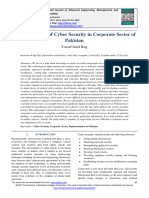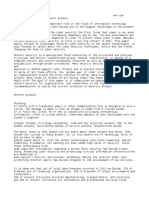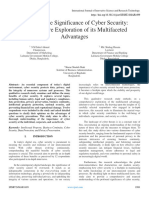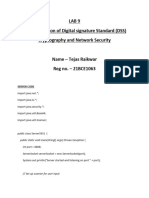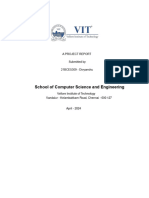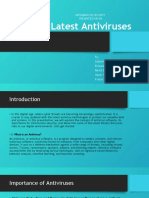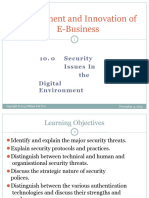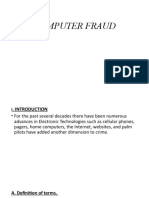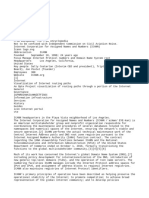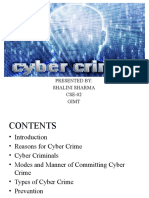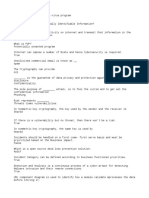International Journal of Science and Society, Volume 6, Issue 1, 2024
Cybersecurity In The Digital Age: Developing
Robust Strategies To Protect Against Evolving
Global Digital Threats And Cyber Attacks
Theodorus Sendjaja1, Irwandi2, Erwan Prastiawan3, Yunita Suryani4, Endang
Fatmawati5
Institut Keuangan Perbankan dan Informatika Asia Perbanas1, Universitas Islam
Negeri Sunan Gunung Djati Bandung, Indonesia2, GoAcademica Research &
Publishing3, Universitas PGRI Ronggolawe, Tuban4, Universitas Diponegoro5
Email: theodorus.sendjaja@perbanas.id
Abstract
In today's digital era, cyber security is a growing challenge, considering increasingly
sophisticated cyber attacks and increasing global digital threats. These threats not only
pose risks to individual privacy but also to the security of critical infrastructure and the
country's economic interests. The need to develop a robust and adaptive cybersecurity
strategy is critical to protecting digital assets and maintaining information security. This
research aims to analyze the global cyber threat landscape and develop effective cyber
security strategies to counter evolving digital threats. The method used is a descriptive
qualitative approach by collecting and analyzing data from relevant previous studies. The
results of the research show that an effective cybersecurity strategy requires an adaptive
and innovative approach, utilizing the latest technology and cross-sector collaboration.
The importance of international collaboration and human resource development in the
field of cyber security was emphasized as a key factor in building stronger defenses
against cyber attacks. Analysis of global cyber threats and their threat actors provides
insight into the importance of cybersecurity education and awareness at all levels of
organizations and society. The security strategy developed must be able to adapt to
changes in technology and attack tactics to ensure effective protection. Cross-sector
collaboration and the development of a strong cybersecurity ecosystem are the
foundations for facing future cybersecurity challenges.
Keywords: Cyber Security, Security Strategy, Digital Threats, Cyber Attacks, Digital Era.
—————————— ◆ ——————————
A. INTRODUCTION
In the current digital era, the development of information and communication
technology has brought significant changes to various aspects of human life. This
transformation creates vast opportunities for individuals, businesses, and
governments to increase efficiency, accessibility, and innovation across a wide range
of services (Al-Rahmi et al., 2020). However, along with this progress, big challenges
have also emerged in the form of increasingly complex and sophisticated
cybersecurity threats. Cyberattacks not only pose risks to individual privacy and the
integrity of personal data, but also threaten a country's critical infrastructure,
economy, and national security (Dunn Cavelty & Wenger, 2020).
IJSOC © 2024
http://ijsoc.goacademica.com
1008
�International Journal of Science and Society, Volume 6, Issue 1, 2024
Constantly changing global dynamics encourage increased reliance on digital
information systems in daily operations, from interpersonal communications to
financial transactions and business operations. Internet of Things (IoT), cloud
computing, big data, and other emergent technologies have become an integral part
of modern society. However, this massive increase in connectivity and data collection
also provides new attack vectors that cyber threat actors can exploit (Jaiswal et al.,
2022).
Cyberattacks have grown from minor annoyances to highly organized
operations, often supported or carried out by organized criminal groups and even
state entities. These types of attacks include, but are not limited to, ransomware,
phishing, Distributed Denial of Service (DDoS), and attacks on critical infrastructure.
The impact of these attacks is extensive, ranging from significant financial losses for
companies, and disruption of public services, to potential risks to public safety and
national security (Sailio et al., 2020).
Cyberattack events in recent years, such as the WannaCry ransomware incident
that spread to more than 150 countries, attacking public health systems, companies,
and governments, have shown how vulnerable the global digital infrastructure is. This
incident sparked an urgent need to develop stronger and more resilient cybersecurity
strategies, not only to detect and respond to attacks that have occurred but also to
prevent future attacks from occurring (Aslan et al., 2023).
In addition, the evolution of cybersecurity policies and regulations in various
countries shows recognition of the seriousness of this threat. However, challenges in
implementing effective cybersecurity practices remain, including skills gaps, resource
availability, and sub-optimal cross-sector collaboration. The gap between
technological developments and the ability to secure them creates loopholes that
threat actors can exploit (Mishra et al., 2022).
It is in this context that the importance of developing a robust and adaptive
cybersecurity strategy becomes critical. The strategy must be able to not only address
current cybersecurity challenges but also be proactive about potential future threats.
Developing this strategy requires a deep understanding of the evolving threat
landscape, as well as a collaborative approach between relevant parties, including the
private sector, government, and the international community (Safitra et al., 2023).
Therefore, research on developing effective cybersecurity strategies becomes
very relevant and urgent. Understanding the characteristics of today's global digital
threats and how they are evolving is an important first step in formulating an effective
response. Thus, efforts to protect critical infrastructure, maintain data privacy and
integrity, and ensure digital security and resilience on a global scale have become
increasingly important in the context of the current digital era.
B. LITERATURE REVIEW
1. Cybersecurity
IJSOC © 2024
http://ijsoc.goacademica.com
1009
�International Journal of Science and Society, Volume 6, Issue 1, 2024
Cyber security, in its essence, is the practice of protecting systems, networks,
and programs from digital attacks aimed at accessing, changing, or destroying
sensitive information, extorting users, or disrupting business processes. With the
development of digital technology, the volume of data we store and process online
continues to increase, as does the potential for cybersecurity risks. In an increasingly
connected world, cybersecurity is not only a technical responsibility, but also a critical
component in business strategy, government policy, and the daily lives of individuals
(Singh & Kumar, 2024).
The concept of cybersecurity covers various aspects, from protection against
malware, which is malicious software such as viruses and ransomware, to advanced
techniques such as phishing, where attackers try to obtain sensitive information
through deception. Additionally, cybersecurity also involves preventing denial-of-
service attacks, which aim to disrupt the normal service of a targeted system, making
it inaccessible to authorized users (Vasani et al., 2023).
To combat these threats, a cybersecurity approach must be comprehensive,
involving a combination of cybersecurity technology, effective policies and
procedures, and user awareness and training. Technologies such as firewalls,
antivirus, and encryption play a vital role in protecting information from
unauthorized access, while policies and procedures help govern how data is accessed
and shared. User awareness and training are other important aspects, as many
cyberattacks succeed due to human error, such as opening suspicious email
attachments or using weak passwords (Chowdhury & Gkioulos, 2021).
Additionally, incident response is an important part of a cybersecurity strategy.
This involves rapid detection of an attack in progress, assessment of the scope and
impact of the attack, and recovery from the attack to minimize damage and restore
normal operations as quickly as possible. Incident response also involves effective
communication with all relevant parties, including authorities where necessary, to
address the issue effectively (Ahmad et al., 2020).
In this digital era, cybersecurity is more important than ever, not only for
organizations and businesses but also for individuals. Cyber threats continue to
evolve, becoming more sophisticated and difficult to detect. Therefore, cybersecurity
efforts must also continue to evolve, with ongoing research and development to deal
with new and emerging threats (Reveron & Savage, 2020). Cybersecurity is not a fixed
state, but rather an ongoing process that requires preparedness, adaptation, and
continuous improvement. In an increasingly connected world, cybersecurity is not
just about protecting data, but also about ensuring continuity and trust in the digital
ecosystems we rely on every day (Annarelli et al., 2020).
Some examples of cyber attacks and threats are as follows:
a) Malware
Malware stands for malicious software. It encompasses a range of software
applications designed to enable unauthorized third-party access to confidential
data or to interfere with the proper functioning of vital infrastructure. Typical
forms of malware are Trojans, spyware, and viruses (Riggs et al., 2023).
IJSOC © 2024
http://ijsoc.goacademica.com
1010
�International Journal of Science and Society, Volume 6, Issue 1, 2024
b) Ransomware
Ransomware describes the strategy and associated technologies employed by
cybercriminals to demand payment from different organizations. If you are
either new to or are expanding your projects on AWS, we offer specialized
resources aimed at safeguarding your essential systems and confidential
information against ransomware attacks (Caviglione et al., 2020).
c) Man-in-the-middle attack
A man-in-the-middle attack occurs when an external entity tries to intercept
unauthorized access within a network while data is being transferred. These
attacks heighten the security vulnerability of confidential data, including
financial information (Thankappan et al., 2022).
d) Phishing
Phishing is a type of cyber threat that employs social engineering tactics to
deceive individuals into disclosing personal identification details. For instance,
cyber criminals dispatch emails that lure users into clicking on a link and
inputting credit card information on a counterfeit payment site. Additionally,
phishing attacks may lead to the downloading of harmful attachments, which
then install malware on company devices (van der Kleij et al., 2023).
e) DDoS
A Distributed Denial of Service (DDoS) attack involves a concerted attempt to
flood a server with an excessive volume of bogus requests. This action obstructs
legitimate users from establishing a connection to or retrieving information
from the targeted server (Wani et al., 2021).
2. Digital Threats
Digital threats refer to potential harm or damage aimed at computer systems,
network infrastructure, and data stored online, originating from malicious sources or
actors in cyberspace. With the development of technology and our dependence on the
digital world, this threat has developed into a complex problem that threatens not
only individuals but also organizations and countries as a whole (Strupczewski, 2021).
Digital threats can come in many forms, from viruses and malware that damage
devices or disrupt operations to more sophisticated cyber attacks such as ransomware,
phishing, and denial of service (DoS) attacks, which can not only damage systems but
can also steal, change, or destroy important information (Lallie et al., 2021).
Phishing attacks, for example, target individuals by luring them into providing
personal or confidential information through fake emails or websites that appear
legitimate. Ransomware, on the other hand, encrypts the victim's data and demands
a ransom payment for the decryption of that data (Alkhalil et al., 2021). Meanwhile,
denial-of-service attacks aim to flood a system with excessive traffic, making it
inaccessible to legitimate users. Beyond these attack methods, digital threats also
include cyber espionage, where malicious actors steal sensitive data for political,
military, or economic gain, as well as critical infrastructure attacks that can disrupt
IJSOC © 2024
http://ijsoc.goacademica.com
1011
�International Journal of Science and Society, Volume 6, Issue 1, 2024
critical services such as electricity, water, and transportation systems (Pour et al.,
2023).
In dealing with digital threats, the main challenge lies in the speed of
technological evolution and the ever-changing attack methods. Malicious actors are
constantly looking for new security vulnerabilities and developing more sophisticated
techniques to avoid detection. This requires a dynamic and adaptive security
approach, which not only involves implementing the latest security technologies but
also promoting awareness and education about good cybersecurity practices among
users. The importance of regular software updates, the use of strong and unique
passwords, and caution in opening email attachments or clicking on links from
unknown sources cannot be overstated (Ma, 2021).
Furthermore, collaboration between government, industry, and the academic
community is critical in combating digital threats. The exchange of information about
threats and vulnerabilities, as well as joint research and development of more effective
security technologies, is key to building stronger defenses against cyberattacks.
Additionally, developing and implementing strong cybersecurity policies and
standards, both at the national and international levels, is an important step in creating
a safer digital environment (Upadhyay, 2020).
In an increasingly connected world, digital threats are one of the biggest
security challenges we face. With threats continuing to evolve and become more
sophisticated, it is important for all parties, from individuals to countries, to adopt a
proactive and collaborative approach to ensuring digital security. It's not just about
protecting data or infrastructure, but also about ensuring trust and stability in the
digital ecosystem that supports our daily lives (Ande et al., 2020).
C. METHOD
To understand in-depth cyber security in the digital era and develop strong
strategies to protect against growing global digital threats and cyber attacks, this
research will be carried out using a descriptive qualitative approach. This approach
was chosen because of its ability to provide a comprehensive understanding of
phenomena through detailed and systematic data collection from various sources. The
data used in this research comes from various research results and previous studies
which still correlate with the research content. These data sources will include
academic publications related to cyber security and security strategies. After the
research data has been successfully collected, the next step is processing the data to
produce valid and reliable research findings. Through this analysis, the research aims
to identify patterns, trends, and relationships in the data that can provide new insights
into effective cybersecurity strategies in the digital era. The goal is to provide
evidence-based recommendations that can help organizations and individuals
develop more robust and adaptive approaches to evolving cyber threats.
IJSOC © 2024
http://ijsoc.goacademica.com
1012
�International Journal of Science and Society, Volume 6, Issue 1, 2024
D. RESULT AND DISCUSSION
1. Global Cyber Threat Landscape Analysis
In the last decade, we have witnessed a significant evolution in the cyber threat
landscape, driven by technological advances and increasing global connectivity.
Recent threat developments show that the tactics, techniques, and procedures used by
threat actors are becoming increasingly sophisticated, with attacks designed to
circumvent traditional security mechanisms and exploit new vulnerabilities.
Advances in technology, such as artificial intelligence and machine learning, have
provided opportunities for threat actors to automate their attacks and increase the
speed and scale of their operations. In this context, ransomware attacks, phishing, and
abuse of cloud infrastructure are becoming increasingly common, demonstrating
threat actors' rapid adaptation to the changing digital environment.
Threat actors in the global cyber landscape also vary, from individuals seeking
financial gain to organized criminal groups with significant resources and state actors
conducting cyber operations for geopolitical purposes. Their motivations can vary
widely, from financial gain to reconnaissance, to sabotage. The existence of a black
market for cyber tools and services makes it easy for even threat actors with limited
technical expertise to launch sophisticated attacks. State actors, in particular, have
demonstrated the ability to conduct complex cyber campaigns, targeting critical
infrastructure and government information systems to gather intelligence or cause
disruption.
Critical industrial and infrastructure sectors, such as healthcare, energy,
finance, and government, have become prime targets for cyberattacks due to the
significant potential impact of disruptions to these services. Attacks on these sectors
can not only cause huge financial losses but also pose risks to public safety and
welfare. For example, ransomware attacks against hospitals can hinder access to
critical medical services, while attacks against industrial control systems can cause
physical damage to critical infrastructure. Vulnerabilities in the software supply chain
have also highlighted risks to the wider sector, as a single vulnerability can be
exploited to attack multiple organizations using infected software.
The challenge of detecting and responding to cyber threats promptly is
becoming increasingly complex as the volume and sophistication of attacks continue
to grow. Many organizations grapple with a lack of resources and expertise to
effectively manage cybersecurity risks. Additionally, threat actors' use of detection
evasion techniques, such as encryption and polymorphism, makes detecting attacks
more difficult. Increased reliance on automated security solutions also poses
challenges, as these systems may not be able to recognize new or unknown threats
without constant updates and monitoring. Response to attack incidents requires rapid
and effective coordination between security teams, management, and external parties
such as law enforcement, which is often hampered by a lack of mature incident
response procedures and challenges in sharing information about threats.
2. The Need for an Adaptive Cybersecurity Strategy
IJSOC © 2024
http://ijsoc.goacademica.com
1013
�International Journal of Science and Society, Volume 6, Issue 1, 2024
In the ever-changing digital era, the cyber threat landscape is evolving at a
surprising pace, forcing companies and organizations to continually adapt their
cybersecurity strategies. These changing threat dynamics, characterized by the
emergence of new technologies and increasingly sophisticated attack tactics, require
a flexible and adaptive approach to developing cybersecurity strategies. Rapid
changes in technology not only open up new opportunities for innovation and
efficiency but also create new vulnerabilities and opportunities for threat actors to
exploit. For example, the adoption of cloud computing, the Internet of Things (IoT),
and 5G mobile networks has expanded the attack surface, making it important to have
a security strategy that can adapt to the changing technological environment.
Integration of the latest security technologies is key in ensuring that
organizations can detect and respond to threats quickly and efficiently. Artificial
Intelligence (AI) and machine learning offer great potential in identifying suspicious
patterns and behavior that may go undetected by traditional security systems. Using
this technology can improve an organization's ability to respond proactively to cyber
threats, reduce detection time, and speed up the recovery process. However, the
implementation of these advanced technologies must be supported by strong security
policies and continuously updated to reflect the dynamic threat landscape.
Developing and updating cybersecurity policies is another important element
in building an adaptive security strategy. This policy should include clear guidelines
on security best practices, incident response procedures, and employee
responsibilities and duties in maintaining cybersecurity. The importance of these
policies lies in their ability to provide a framework for organizations to deal with cyber
threats, ensuring that there are clear procedures to follow when threats are detected.
These policies should be regularly reviewed and updated to ensure that they remain
relevant to current cyber threats and meet changing regulatory requirements.
Apart from technology and policy, cyber security education and awareness
play a crucial role in strengthening defenses against cyber threats. Increasing cyber
security awareness and education at all levels of organizations and society is critical
in reducing the risk of cyber attacks. Informed and alert employees can act as the first
layer of defense against phishing attacks and other manipulative tactics used by threat
actors. A comprehensive and ongoing cybersecurity training program can help ensure
that all members of an organization understand cybersecurity risks and know how to
act safely in the digital environment. At a societal level, awareness campaigns can help
increase public understanding of the importance of cybersecurity and how to protect
personal and sensitive information.
Taking all these aspects into account, it is clear that building an adaptive
cybersecurity strategy requires not only the use of the latest security technologies but
also the development of comprehensive security policies and ongoing efforts in
security education and awareness. The combination of advanced technology, updated
policies, and heightened security awareness creates a strong foundation for protecting
organizations from the ever-evolving cyber threat landscape. Through this holistic
and adaptive approach, organizations can strengthen their resilience to cyber-attacks.
IJSOC © 2024
http://ijsoc.goacademica.com
1014
�International Journal of Science and Society, Volume 6, Issue 1, 2024
3. Cross-Sector Cooperation in Cyber Security
In facing increasingly complex and widespread cyber threats, cross-sector
collaboration is key to building an effective defense. Cooperation between the public
and private sectors in sharing intelligence on threats and best security practices is one
of the important pillars of cybersecurity strategy. This allows both sectors to leverage
each other's strengths and resources, such as technical expertise, analytical capacity,
and access to classified or sensitive information. For example, the private sector, with
its rapid technological innovation and expertise in developing cybersecurity solutions,
can provide valuable insight into current threats and how to address them.
Meanwhile, the public sector, with its access to national security intelligence and
regulatory frameworks, can provide a broader context on cyber threats and support
security initiatives with policy and resources. This kind of cooperation not only
strengthens threat detection and response capabilities but also helps in the
development of more effective security standards.
The role of the international community in strengthening defense against
global cyber threats cannot be ignored. In the global digital ecosystem, cyberattacks
often know no geographic boundaries, making international cooperation critical in
confronting this shared threat. Joint initiatives, such as exchanging information on
threats, coordinating responses to cyber incidents across countries, and developing
common policy frameworks, can improve cyber defense capabilities globally.
Additionally, international cooperation helps in overcoming legal and jurisdictional
challenges that often hinder law enforcement efforts against cybercrime.
Standardization and regulation play an important role in improving overall
cybersecurity. Clear and consistent security standards help organizations implement
effective security practices, while regulations can encourage the implementation of
these standards through compliance requirements. In the context of cross-sector
collaboration, standardization, and regulation can be the basis for collaboration,
ensuring that all parties operate with the same security understanding and goals. It
also facilitates a smoother exchange of security information between sectors, as the
standard provides a common framework for communication and risk understanding.
Developing a strong cybersecurity ecosystem involves more than just
cooperation between the public and private sectors. It also requires active
participation from academia, industry, government, and the research community.
Such an ecosystem drives innovation in cybersecurity technology and strategy,
enabling the exchange of valuable knowledge and research. By combining expertise
from various disciplines and sectors, more holistic and effective security solutions can
be developed. Additionally, this ecosystem supports the development of
cybersecurity talent through education and training, ensuring that there is a steady
flow of skilled workforce ready to face future cybersecurity challenges.
Overall, cross-sector collaboration in cybersecurity not only strengthens defenses
against threats but also promotes innovation and joint learning. By working together,
IJSOC © 2024
http://ijsoc.goacademica.com
1015
�International Journal of Science and Society, Volume 6, Issue 1, 2024
various parties can build a cyber security system that is more resilient, adaptive, and
able to face ever-evolving cyber threats.
4. Innovation and the Future of Cybersecurity
Technology innovation has become a double-edged sword in the context of
cybersecurity. On the one hand, emerging technologies such as blockchain, quantum
computing, and the Internet of Things (IoT) offer opportunities to improve the
security and efficiency of information systems. Blockchain, with its decentralized data
structure and resistance to modification, promises increased security in online
transactions and data exchange. Meanwhile, quantum computing offers the potential
to overcome complex cryptographic challenges, although it also poses a threat to
current encryption standards. IoT, with its network of interconnected devices, opens
up opportunities for greater automation and efficiency but also expands the attack
surface for cyber threat actors. Therefore, cybersecurity researchers and developers
need to explore and integrate these technologies in ways that minimize risks and
maximize security benefits.
Anticipation of future threats is a critical aspect of innovation in cybersecurity.
Ongoing research and development are necessary to not only understand new
technologies but also to anticipate how threat actors might exploit these technologies.
Developing proactive security solutions, that can detect and respond to threats before
they cause damage, is a critical step in safeguarding cyber security in the future. This
requires significant investment in cybersecurity research, as well as collaboration
between academia, industry, and government to share knowledge and resources.
Learning from previous cybersecurity incidents is also an important
component in developing stronger defenses. A thorough analysis of security breaches,
cyberattacks, and other incidents can reveal weaknesses in current security
infrastructure and practices, as well as provide insight into the tactics and techniques
used by threat actors. By understanding past mistakes, organizations can take concrete
steps to improve their security, develop more effective incident response protocols,
and build systems that are more resilient against future attacks.
Ultimately, human resource development is a key pillar in the future of
cybersecurity. The shortage of skilled workforce in cybersecurity is a global challenge
that requires urgent attention. Investments in cybersecurity education and training,
from the school level to professional training programs, are key to developing a
workforce capable of dealing with increasingly complex cyber threats. This includes
not only technical training but also the development of the analytical and problem-
solving skills necessary to identify and respond to cyber threats effectively. Career
development and a clear professional pathway in cybersecurity can also help attract
and retain talent in this field.
Overall, the future of cybersecurity depends on the ability to innovate and
adapt quickly to changes in technology and the threat landscape. This requires a
holistic approach involving the latest technology, proactive research, learning from
IJSOC © 2024
http://ijsoc.goacademica.com
1016
�International Journal of Science and Society, Volume 6, Issue 1, 2024
the past, and continuous development of human resources. By focusing on these
aspects, we can hope to build a safer digital world for generations to come.
E. CONCLUSION
Cybersecurity in the digital era is an ever-evolving challenge, requiring
adaptive, innovative, and collaborative strategies. The development of new
technologies such as blockchain, quantum computing, and the Internet of Things (IoT)
brings new opportunities and challenges in cybersecurity, requiring a proactive
approach to anticipating and responding to threats. Cross-sector collaboration,
including partnerships between the public and private sectors, as well as international
cooperation, is key to sharing threat intelligence and best security practices.
Standardization and regulation, along with the development of a strong cybersecurity
ecosystem, support these efforts. Furthermore, the importance of human resource
development cannot be ignored. Cyber security education and training, as well as
career development for professionals in this field, are fundamental to building a
workforce ready to face increasingly complex cyber threats. By focusing on
technological innovation, cross-sector collaboration, and human resource
development, we can strengthen our defenses against growing cyberattacks.
Awareness and readiness to adapt to changing threat dynamics will be an important
factor in protecting digital assets and critical infrastructure in the future.
REFERENCES
1. Ahmad, A., Desouza, K. C., Maynard, S. B., Naseer, H., & Baskerville, R. L.
(2020). How integration of cyber security management and incident response
enables organizational learning. Journal of the Association for Information Science
and Technology, 71(8), 939-953.
2. Alkhalil, Z., Hewage, C., Nawaf, L., & Khan, I. (2021). Phishing attacks: A recent
comprehensive study and a new anatomy. Frontiers in Computer Science, 3,
563060.
3. Al-Rahmi, W. M., Alzahrani, A. I., Yahaya, N., Alalwan, N., & Kamin, Y. B.
(2020). Digital communication: Information and communication technology
(ICT) usage for education sustainability. Sustainability, 12(12), 5052.
4. Ande, R., Adebisi, B., Hammoudeh, M., & Saleem, J. (2020). Internet of Things:
Evolution and technologies from a security perspective. Sustainable Cities and
Society, 54, 101728.
5. Annarelli, A., Nonino, F., & Palombi, G. (2020). Understanding the
management of cyber resilient systems. Computers & industrial engineering, 149,
106829.
6. Aslan, Ö., Aktuğ, S. S., Ozkan-Okay, M., Yilmaz, A. A., & Akin, E. (2023). A
comprehensive review of cyber security vulnerabilities, threats, attacks, and
solutions. Electronics, 12(6), 1333.
IJSOC © 2024
http://ijsoc.goacademica.com
1017
�International Journal of Science and Society, Volume 6, Issue 1, 2024
7. Caviglione, L., Choraś, M., Corona, I., Janicki, A., Mazurczyk, W., Pawlicki, M.,
& Wasielewska, K. (2020). Tight arms race: Overview of current malware
threats and trends in their detection. IEEE Access, 9, 5371-5396.
8. Chowdhury, N., & Gkioulos, V. (2021). Cyber security training for critical
infrastructure protection: A literature review. Computer Science Review, 40,
100361.
9. Dunn Cavelty, M., & Wenger, A. (2020). Cyber security meets security politics:
Complex technology, fragmented politics, and networked
science. Contemporary Security Policy, 41(1), 5-32.
10. Jaiswal, A., Arun, C. J., & Varma, A. (2022). Rebooting employees: Upskilling
for artificial intelligence in multinational corporations. The International Journal
of Human Resource Management, 33(6), 1179-1208.
11. Lallie, H. S., Shepherd, L. A., Nurse, J. R., Erola, A., Epiphaniou, G., Maple, C.,
& Bellekens, X. (2021). Cyber security in the age of COVID-19: A timeline and
analysis of cyber-crime and cyber-attacks during the pandemic. Computers &
security, 105, 102248.
12. Ma, C. (2021). Smart city and cyber-security; technologies used, leading
challenges and future recommendations. Energy Reports, 7, 7999-8012.
13. Mishra, A., Alzoubi, Y. I., Anwar, M. J., & Gill, A. Q. (2022). Attributes
impacting cybersecurity policy development: An evidence from seven
nations. Computers & Security, 120, 102820.
14. Pour, M. S., Nader, C., Friday, K., & Bou-Harb, E. (2023). A Comprehensive
Survey of Recent Internet Measurement Techniques for Cyber
Security. Computers & Security, 103123.
15. Reveron, D. S., & Savage, J. E. (2020). Cybersecurity convergence: digital
human and national security. Orbis, 64(4), 555-570.
16. Riggs, H., Tufail, S., Parvez, I., Tariq, M., Khan, M. A., Amir, A., ... & Sarwat, A.
I. (2023). Impact, Vulnerabilities, and Mitigation Strategies for Cyber-Secure
Critical Infrastructure. Sensors, 23(8), 4060.
17. Safitra, M. F., Lubis, M., & Fakhrurroja, H. (2023). Counterattacking cyber
threats: A framework for the future of cybersecurity. Sustainability, 15(18),
13369.
18. Sailio, M., Latvala, O. M., & Szanto, A. (2020). Cyber threat actors for the factory
of the future. Applied Sciences, 10(12), 4334.
19. Singh, B., & Kumar, B. (2024). A Comprehensive Analysis Of Key Factors
Causing Various Kinds Of Cyber-Attacks In Higher Educational
Institute’s. Journal of Research Administration, 6(1).
20. Strupczewski, G. (2021). Defining cyber risk. Safety science, 135, 105143.
21. Thankappan, M., Rifà-Pous, H., & Garrigues, C. (2022). Multi-channel man-in-
the-middle attacks against protected wi-fi networks: A state of the art
review. Expert Systems with Applications, 118401.
IJSOC © 2024
http://ijsoc.goacademica.com
1018
�International Journal of Science and Society, Volume 6, Issue 1, 2024
22. Upadhyay, N. (2020). Demystifying blockchain: A critical analysis of
challenges, applications and opportunities. International Journal of Information
Management, 54, 102120.
23. van der Kleij, R., van ‘t Hoff—De Goede, S., van de Weijer, S., & Leukfeldt, R.
(2023). Social engineering and the disclosure of personal identifiable
information: Examining the relationship and moderating factors using a
population-based survey experiment. Journal of Criminology,
26338076231162660.
24. Vasani, V., Bairwa, A. K., Joshi, S., Pljonkin, A., Kaur, M., & Amoon, M. (2023).
Comprehensive analysis of advanced techniques and vital tools for detecting
malware intrusion. Electronics, 12(20), 4299.
25. Wani, S., Imthiyas, M., Almohamedh, H., Alhamed, K. M., Almotairi, S., &
Gulzar, Y. (2021). Distributed denial of service (DDoS) mitigation using
blockchain—A comprehensive insight. Symmetry, 13(2), 227.
IJSOC © 2024
http://ijsoc.goacademica.com
1019



























